Exceptional Conference Talks from LDS Church History
Brigham Young: Taking on the Visage of Joseph Smith
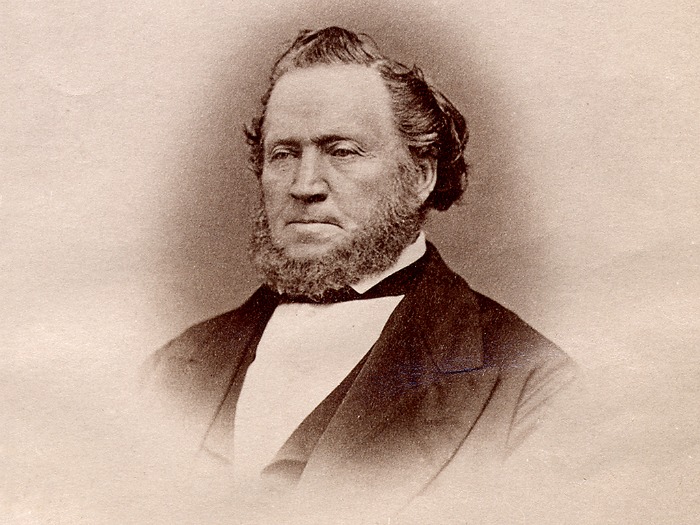 After the martyrdom of Joseph Smith, the apostles gathered in to Nauvoo from their missions. Sidney Rigdon, estranged from the Church, now wanted to be its “guardian.” He called a conference for a certain date, but it was scheduled by Elder Marks a bit later, for Thursday, August 8, 1844, after Brigham Young and other apostles finally arrived in Nauvoo.
After the martyrdom of Joseph Smith, the apostles gathered in to Nauvoo from their missions. Sidney Rigdon, estranged from the Church, now wanted to be its “guardian.” He called a conference for a certain date, but it was scheduled by Elder Marks a bit later, for Thursday, August 8, 1844, after Brigham Young and other apostles finally arrived in Nauvoo.
The meeting’s purpose was to sustain a new leader of the Church. Rigdon had met with the apostles, who were united quickly. The apostles firmly felt they held all the keys of the kingdom.
Rigdon claimed to have had a vision, an extension of the one he shared with Joseph that became Section 76 of the Doctrine and Covenants. It failed to impress the Brethren. Wilford Woodruff recorded in his journal that Sidney’s statement was a “long story. It was a kind of second class vision.”
A solemn assembly was called for later that day.
On that day a miracle occurred before the body of the Church—Brigham Young was transfigured before the people, and the succession crisis of the Church was resolved…. Sidney Rigdon spoke for an hour and a half about his desires to be the guardian of the Church, but he awakened no emotion and said nothing that marked him as the true leader. Brigham Young told the audience that he would rather have spent a month mourning the dead Prophet than so quickly attend to the business of appointing a new shepherd. While he was speaking, he was miraculously transfigured before the people.
People of all ages were present, and they later recorded their experiences. Benjamin F. Johnson, twenty-six at that time, remembered, “As soon as he [Brigham Young] spoke I jumped upon my feet, for in every possible degree it was Joseph’s voice, and his person, in look, attitude, dress and appearance was Joseph himself, personified; and I knew in a moment the spirit and mantle of Joseph was upon him.”
Zina Huntington, who was a young woman twenty-one years old at that time, said “President Young was speaking. It was the voice of Joseph Smith—not that of Brigham Young. His very person was changed. … I closed my eyes. I could have exclaimed, I know that is Joseph Smith’s voice! Yet I knew he had gone. But the same spirit was with the people.”
This miracle brought the Saints in unison under the leadership of Brigham Young. Read more in Church History in the Fulness of Times.
Brigham Young: True Religion Means Rescuing Stranded Pioneers
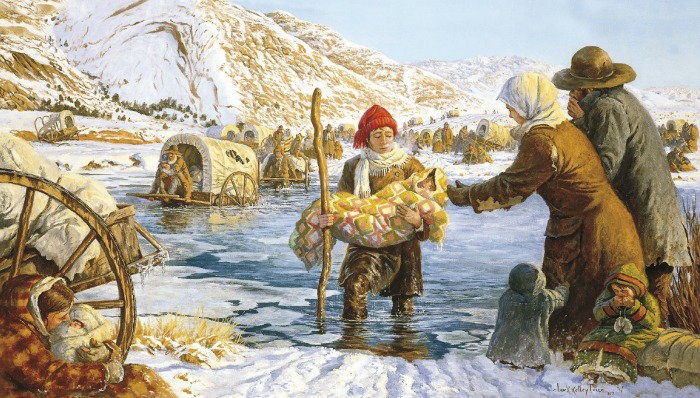 “As the Saints prepared for general conference in Salt Lake City in October 1856, everyone assumed that the arrival of the third handcart company ended the immigration that year. But Franklin D. Richards, who had come into the valley two days prior to the conference, announced that two more handcart companies and two ox-cart supply trains were still on the plains and desperately needed food and clothing to finish the journey.
“As the Saints prepared for general conference in Salt Lake City in October 1856, everyone assumed that the arrival of the third handcart company ended the immigration that year. But Franklin D. Richards, who had come into the valley two days prior to the conference, announced that two more handcart companies and two ox-cart supply trains were still on the plains and desperately needed food and clothing to finish the journey.
“When Brigham Young learned that these companies were still on the plains, he spoke to the Saints who had gathered for general conference. The meeting was actually held on 5 October, one day before the conference officially convened. Brigham Young said:
“The text will be, ‘to get them here.’ …
“I shall call upon the Bishops this day, I shall not wait until to-morrow, nor until next day, for 60 good mule teams and 12 or 15 wagons. …
“I will tell you all that your faith, religion, and profession of religion, will never save one soul of you in the celestial kingdom of our God, unless you carry out just such principles as I am now teaching you. Go and bring in those people now on the plains.”
The response was impressive. Sixteen wagon loads of food and supplies were quickly assembled; and on the morning of 7 October, sixteen good four-mule teams and twenty-seven hardy young men (known as Brigham Young’s “Minute Men”) headed eastward with the first provisions. More help was solicited and obtained from all parts of the territory. By the end of October, two hundred and fifty teams were on the road to give relief” (Church History in the Fulness of Times).
Thomas B. Marsh: His Apostasy and Return to the Church
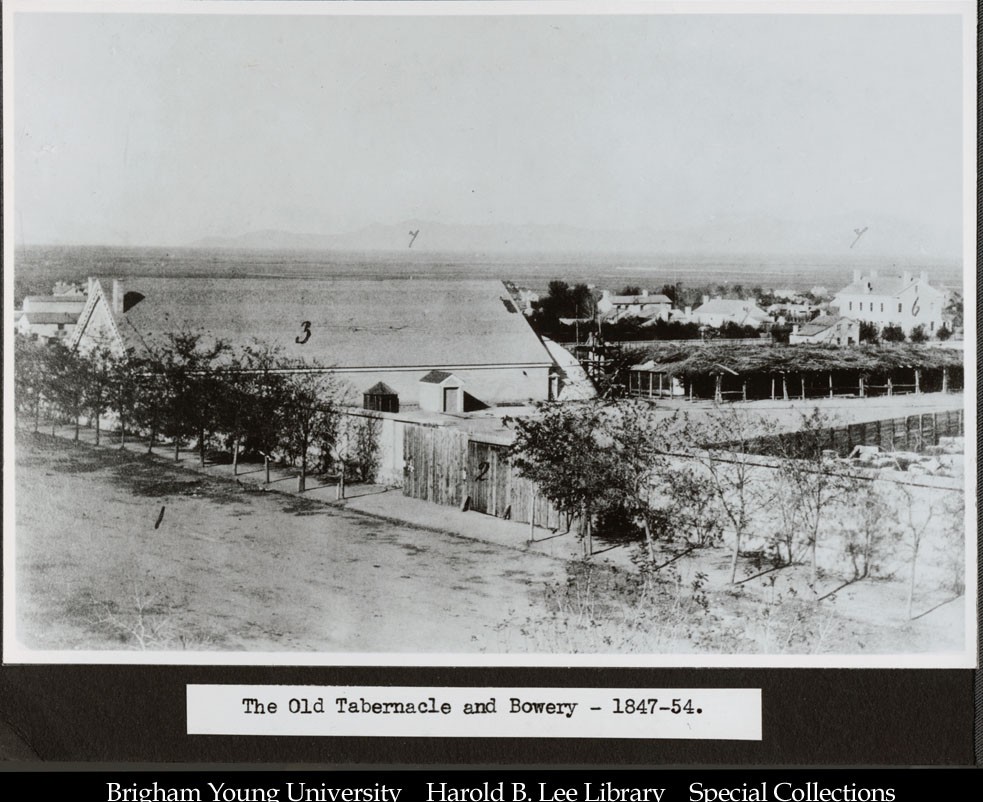 Thomas B. Marsh had once been President of the Twelve but lost his testimony, rebelled against the Church, and left. Penitent, he made his way to Salt Lake City and was invited by Prophet Brigham Young to speak to the membership of the Church in the Bowery in Salt Lake on Sunday, September 6, 1857.
Thomas B. Marsh had once been President of the Twelve but lost his testimony, rebelled against the Church, and left. Penitent, he made his way to Salt Lake City and was invited by Prophet Brigham Young to speak to the membership of the Church in the Bowery in Salt Lake on Sunday, September 6, 1857.
Brother Marsh said,
I have sought diligently to know the Spirit of Christ since I turned my face Zionward, and I believe I have obtained it. I have frequently wanted to know how my apostacy began, and I have come to the conclusion that I must have lost the Spirit of the Lord out of my heart.
The next question is, “How and when did you lose the Spirit?” I became jealous of the Prophet, and then I saw double, and overlooked everything that was right, and spent all my time in looking for the evil; and then, when the Devil began to lead me, it was easy for the carnal mind to rise up, which is anger, jealousy, and wrath. I could feel it within me; I felt angry and wrathful; and the Spirit of the Lord being gone, as the Scriptures say, I was blinded, and I thought I saw a beam in brother Joseph’s eye, but it was nothing but a mote, and my own eye was filled with the beam; but I thought I saw a beam in his, and I wanted to get it out; and, as brother Heber says, I got mad, and I wanted everybody else to be mad. I talked with Brother Brigham and Brother Heber, and I wanted them to be mad like myself; and I saw they were not mad, and I got madder still because they were not. Brother Brigham, with a cautious look, said, “Are you the leader of the Church, brother Thomas?” I answered, “No.” “Well then,” said he, “Why do you not let that alone?”
Well, this is about the amount of my hypocrisy–I meddled with that which was not my business. But let me tell you, my brethren and friends, if you do not want to suffer in body and mind, as I have done,–if there are any of you that have the seeds of apostacy in you, do not let them make their appearance, but nip that spirit in the bud; for it is misery and affliction in this world, and destruction in the world to come (BYU.edu).
Wilford Woodruff: The End of Earthly Polygamy
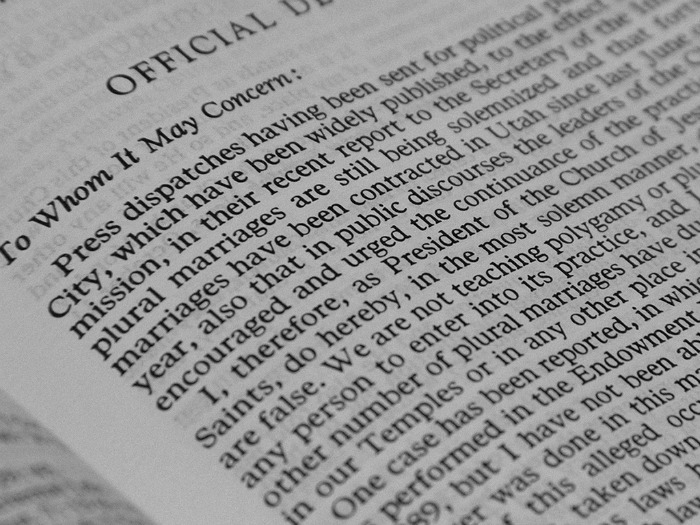 Under the Edmunds-Tucker Acts, the U.S. government hoped to end polygamy. The Edmunds-Tucker Act of 1887 also included provisions aimed at destroying the Church as a political and economic entity. The law officially dissolved The Church of Jesus Christ of Latter-day Saints as a legal corporation and required the Church to forfeit to the government all property in excess of fifty thousand dollars.
Under the Edmunds-Tucker Acts, the U.S. government hoped to end polygamy. The Edmunds-Tucker Act of 1887 also included provisions aimed at destroying the Church as a political and economic entity. The law officially dissolved The Church of Jesus Christ of Latter-day Saints as a legal corporation and required the Church to forfeit to the government all property in excess of fifty thousand dollars.
Many of its leaders, husbands, and fathers were imprisoned. Wives were forced to testify against their husbands, voting rights were curtailed, and life became very difficult for the Saints.
Wilford Woodruff was 80 when he began to lead the Church. Although arrests and imprisonments caused families to suffer, the greatest problem for the Church was its inability to acquire and hold the funds necessary to build temples, do missionary work, publish material, and provide for the welfare of the Saints. It was the end of August when President Woodruff received confirmation that the U.S. government, in spite of an 1888 agreement promising that temples would not be disturbed, was going to confiscate them.
President Woodruff said later that the Lord had shown him by revelation exactly what would take place if plural marriage did not cease. The utter destruction of the Church. After a great spiritual struggle, Woodruff drafted the Manifesto, now Official Declaration 1 in the Doctrine and Covenants, ending polygamy among the Saints.
General conference convened Saturday morning, 4 October 1890, and lasted three days. It was on the third day of the conference that President George Q. Cannon announced the Manifesto and then asked Orson F. Whitney, then bishop of the Salt Lake City 18th Ward, to read the document. The Saints in attendance, recognizing the authority of the Prophet and the Brethren, unanimously accepted it (from Church History in the Fulness of Times).
Lorenzo Snow: Pay your Tithing
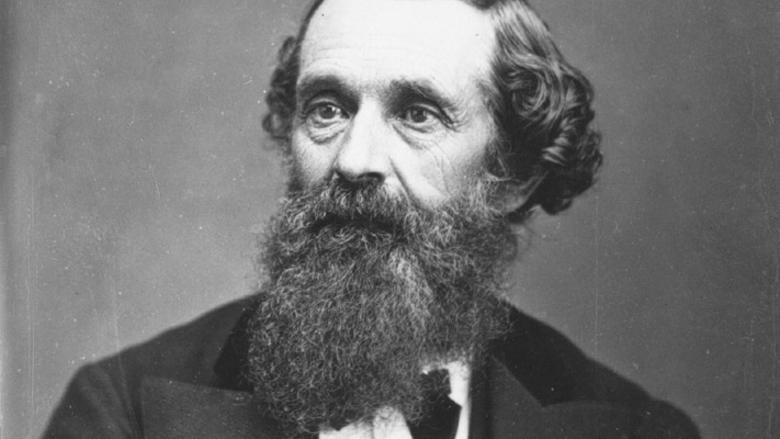
Even after Prophet Lorenzo Snow attached the punishment of excommunication for those still practicing polygamy, the Church did not recover financially. The Church went about $300,000 in debt as a direct result of the Edmunds-Tucker Act. It was also taking care of the families of men jailed for plural marriage, as well as their legal fees and court costs and its own legal expenses.
Tithing revenues had declined in the 1880s because members had been reluctant to contribute when the federal government was confiscating the money. The Church was forced to borrow money from worldly financial institutions. President Lorenzo Snow prayed long and hard about the situation, desiring to use the Church’s resources for forwarding the Lord’s work, and to bring it to a sound financial situation.
He visited Southern Utah during a period of terrible drought. On Wednesday, 17 May 1899, at the opening session of the conference in the St. George Tabernacle, President Snow told the Saints that “we are in your midst because the Lord directed me to come; but the purpose of our coming is not clearly known at the present, but this will be made known to me during our sojourn among you.”
LeRoi C. Snow, son of the President, who was reporting the conference for the Deseret News, recalled what happened: “All at once father paused in his discourse. Complete stillness filled the room. I shall never forget the thrill as long as I live. When he commenced to speak again his voice strengthened and the inspiration of God seemed to come over him, as well as over the entire assembly. His eyes seemed to brighten and his countenance to shine. He was filled with unusual power. Then he revealed to the Latter-day Saints the vision that was before him.”
President Snow told the Saints that he could see that the people had neglected the law of tithing and that the Church would be relieved of debt if members would pay a full and honest tithing. He then said that the Lord was displeased with the Saints for failing to pay their tithing and promised them that if they would pay their tithes the drought would be removed and they would have a bounteous harvest.
Under inspiration, he had set in motion the program that would, by 1907, completely free the Church from debt. Many Saints testified that not only were the windows of heaven opened to save the Church, but those who followed this divine law were spiritually and temporally blessed as well (Church History in the Fulness of Times).
Boyd K. Packer: Spiritual Crocodiles

Stories always make for the most memorable General Conference talks, and this one by Boyd K. Packer stays with the listener forever. We sometimes think we know the lay of the land and fail to see the dangers around us and fail to heed those who do.
Elder Packer gave this talk in April 1976 and aimed it especially toward the youth of the Church.
“The antelope, particularly, were very nervous. They would approach the mud hole, only to turn and run away in great fright. I could see there were no lions about and asked the guide why they didn’t drink. His answer, and this is the lesson, was ‘Crocodiles.’
“I knew he must be joking and asked him seriously, ‘What is the problem?’ The answer again: ‘Crocodiles.’
“Nonsense,” I said. ‘There are no crocodiles out there. Anyone can see that.’”
Bruce R McConkie: His Final Testimony
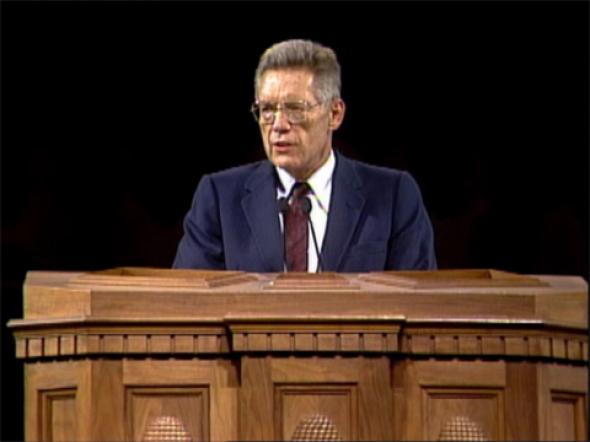 Actually called The Purifying Power of Gethsemane, this moving talk is remembered with affection and gratitude by all who heard it. Bruce R. was dying of cancer at the time. He delivered this talk in April General Conference, 1985, and died a short time later on April 19th. This was his final, emotional testimony.
Actually called The Purifying Power of Gethsemane, this moving talk is remembered with affection and gratitude by all who heard it. Bruce R. was dying of cancer at the time. He delivered this talk in April General Conference, 1985, and died a short time later on April 19th. This was his final, emotional testimony.
“And now, as pertaining to this perfect atonement, wrought by the shedding of the blood of God—I testify that it took place in Gethsemane and at Golgotha, and as pertaining to Jesus Christ, I testify that he is the Son of the Living God and was crucified for the sins of the world. He is our Lord, our God, and our King. This I know of myself independent of any other person.
“I am one of his witnesses, and in a coming day I shall feel the nail marks in his hands and in his feet and shall wet his feet with my tears.
“But I shall not know any better then than I know now that he is God’s Almighty Son, that he is our Savior and Redeemer, and that salvation comes in and through his atoning blood and in no other way.”
Ezra Taft Benson: Beware of Pride
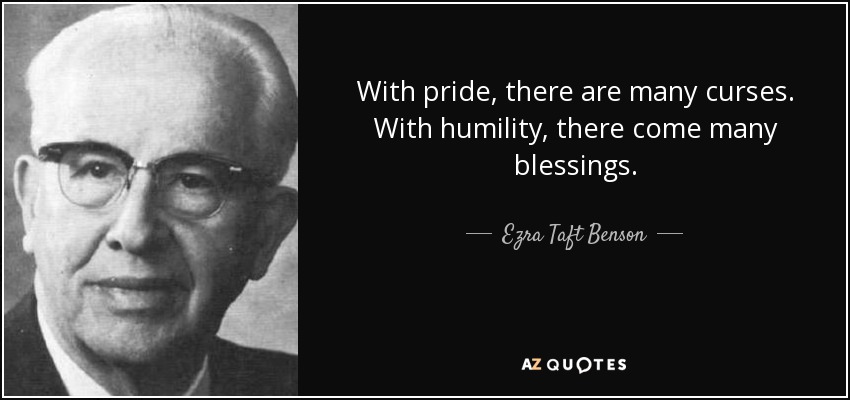 President Ezra Taft Benson delivered this address in April 1989 General Conference. It is a landmark talk on the evils of pride.
President Ezra Taft Benson delivered this address in April 1989 General Conference. It is a landmark talk on the evils of pride.“Most of us think of pride as self-centeredness, conceit, boastfulness, arrogance, or haughtiness. All of these are elements of the sin, but the heart, or core, is still missing.
“The central feature of pride is enmity—enmity toward God and enmity toward our fellowmen. Enmity means “hatred toward, hostility to, or a state of opposition.” It is the power by which Satan wishes to reign over us” (LDS.org – General Conference).
BONUS: BYU Devotionals by Hugh B. Brown
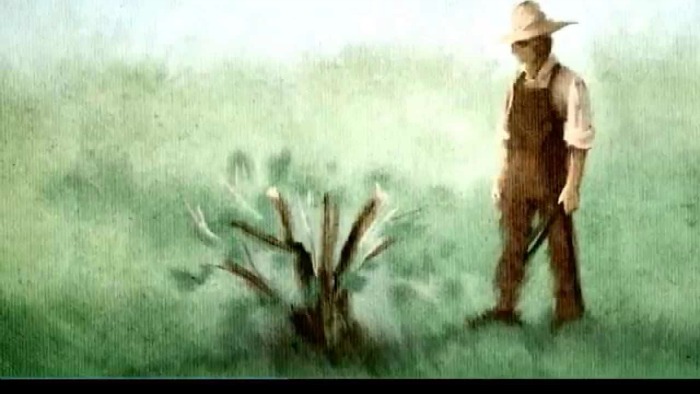
Profile of a Prophet
John, the beloved disciple of Jesus, declared, “The testimony of Jesus is the spirit of prophecy” (Revelation 19:10). If Joseph Smith had the testimony of Jesus, he had the spirit of prophecy. And if he had the spirit of prophecy, he was a prophet.
I submit to you, and I submitted to my friend, that as much as any man who ever lived, he had a testimony of Jesus, for, like the apostles of old, he saw Him and heard Him speak. He gave his life for that testimony. I challenge any man to name one who has given more evidence of the divine calling of Jesus Christ than did the Prophet Joseph Smith.
God is the Gardener
It is important not only that you keep growing but that you be versatile, adaptive, and unafraid to venture. In other words, be up to date. Seek to obtain a certain flexibility of mind that will inspire you to listen, to learn, and to adapt as you move forward into a new and ever-expanding universe.


